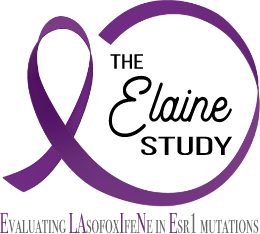Now recruiting:
The ELAINE-3 study
Sermonix is now recruiting for ELAINE-3 at clinical trial sites across the United States, Europe, Japan, Israel, and Canada. Like ELAINE-1 and ELAINE-2, this study will investigate the oral drug, lasofoxifene, a novel targeted endocrine agent, for the treatment of locally advanced or metastatic ER+/HER2- breast cancer expressing an ESR1 mutation in women and men.

The ELAINE studies in context
The Sermonix ELAINE studies continue to investigate the drug lasofoxifene for the treatment of metastatic breast cancer expressing an ESR1 mutation. Let’s take a closer look at breast cancer, metastatic breast cancer, the ESR1 mutation, lasofoxifene, and more.

~3.8 million
US women have breast cancer1

~290,000
US women are diagnosed with invasive breast cancer each year1
Understanding estrogen receptor-positive breast cancer
Breast cancers that have estrogen receptors—proteins that bind to the hormone, estrogen—are called estrogen receptor-positive (ER+) cancers. These cancer cells may need estrogen to grow and may stop growing or die when treated with substances that block the binding action of estrogen.
~70%
of all breast cancers are
estrogen receptor-positive (ER+)3
The ELAINE studies concentrate on metastatic breast cancer
Metastatic breast cancer, explained
The ELAINE studies focus specifically on the treatment of breast cancer that has spread (metastasized) beyond the breast and nearby lymph nodes. Cancer that begins in breast tissue, then moves to other areas of the body, is called metastatic breast cancer (mBC). You may also hear metastatic breast cancer referred to as “stage IV breast cancer.”4
150,000+
US women live with
metastatic breast cancer5
The ELAINE studies focus specifically on mBC expressing an ESR1 mutation
What is an ESR1 mutation?
The estrogen receptor 1 gene, also called ESR1, is a gene that encodes the estrogen receptor proteins that can bind to estrogen inside cells. During certain metastatic breast cancer treatment, some tumors may undergo changes that alter the ESR1 gene.6-8 Physicians call these alterations ESR1 mutations.
~40%
of those with ER+/HER2- metastatic breast
cancer can have an ESR1 mutation9
Why the ELAINE studies focus on the ESR1 mutation
Background on endocrine therapy
Endocrine therapy (ET)—also called hormone-blocking therapy or hormone treatment—can help to treat cancers that use hormones to grow, like breast cancer. ET targets the estrogen receptor pathway to help reduce or stop the growth of hormone-sensitive tumors by blocking the body’s ability to produce hormones or by interfering with the effects of hormones on breast cancer cells.10
ET and ESR1 mutations
Research has shown that in the metastatic setting, ESR1 mutations may cause resistance to certain types of endocrine therapies.7 Treatment resistance may help explain why those who have mBC with an ESR1 mutation sometimes have a shorter survival period than those without the mutation.6
Median months of overall survival6

EXPRESSING
ESR1 mutation

NOT EXPRESSING
ESR1 mutation
An analysis was performed to adjust for the potential effects of prior hormonal therapy, visceral disease, and ECOG status.
The ELAINE trials are investigating lasofoxifene as a treatment for metastatic breast cancer expressing an ESR1 mutation
What is lasofoxifene?
Lasofoxifene is a novel targeted endocrine agent being studied in women and men with locally advanced or metastatic estrogen receptor-positive/human epidermal growth factor 2-negative (ER+/HER2-) breast cancer expressing an ESR1 mutation. It is the only investigational oral endocrine agent focused exclusively on these mutations.
The ELAINE studies continue to evaluate whether lasofoxifene may slow the progression of disease and improve quality of life in patients who have metastatic breast cancer expressing an ESR1 mutation. Lasofoxifene may help block estrogen receptors, which use the hormone estrogen to stimulate tumor cell growth.


Lasofoxifene at-a-glance
This investigational oral drug:

Lasofoxifene may be different from other treatments
Lasofoxifene has a well-characterized safety profile at doses up to 10 mg in extensive non-oncologic studies. In oncologic studies ELAINE-1 and ELAINE-2, where a 5-mg dose was used, the safety profile was consistent with non-oncologic studies, with no new adverse events reported.
Send me the latest news
By subscribing, you agree to receive the latest news and updates from us.
References: 1. National Cancer Institute SEER Program. Cancer Stat Facts: Female Breast Cancer. Accessed July 19, 2022. https://seer.cancer.gov/statfacts/html/breast.html 2. Breastcancer.org. Key Statistics for Breast Cancer. Accessed July 19, 2022. https://www.breastcancer.org/facts-statistics 3. Scheidemann ER, Shajahan-Haq AN. Int J Mol Sci. 2021;22(22):12292. 4. Cancer.net. Breast Cancer – Metastatic: Introduction. Accessed July 19, 2022. https://www.cancer.net/cancer-types/breast-cancer-metastatic/introduction 5. Study estimates number of U.S. women living with metastatic breast cancer. News Release. National Cancer Institute. May 18, 2017. Accessed July 19, 2022. https://www.cancer.gov/news-events/press-releases/2017/metastatic-breast-cancer-survival-rates 6. Chandarlapaty S, Chen D, He W, et al. JAMA Oncol. 2016;2(10):1310-1315. 7. Jesselsohn R, Buchwalter G, De Angelis C, Brown M, Schiff R. Nat Rev Clin Oncol. 2015;12(10):573-583. 8. Zundelevich A, Dadiani M, Kahana-Edwin S, et al. Breast Cancer Res. 2020;22(1):28. 9. Cogliati V, Capici S, Pepe FF, et al. Life (Basel). 2022;12(3):378. 10. Reinert T, Saad ED, Barrios CH, Bines J. Front Oncol. 2017;7:26.